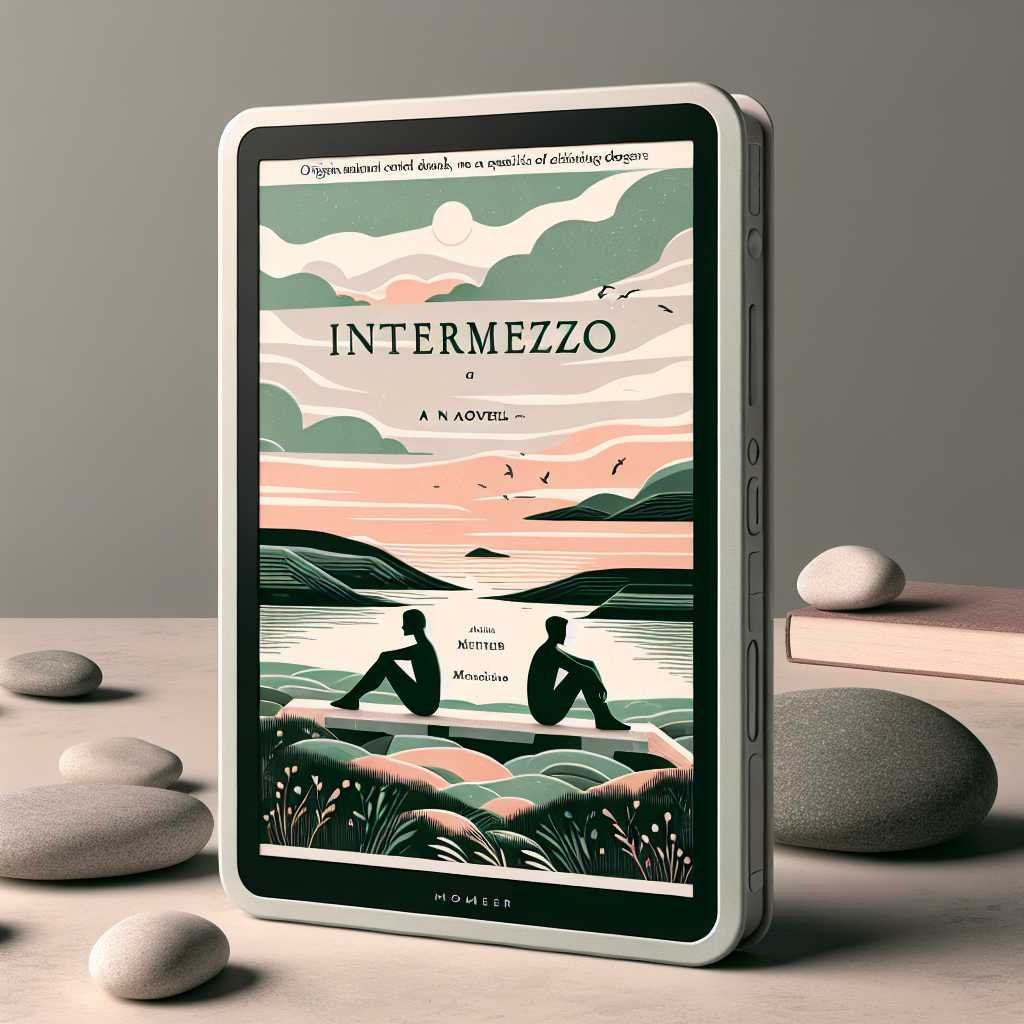Intermezzo by Sally Rooney (Kindle Edition) Review: A Quietly Devastating Portrait of Brothers, Love, and Loss
What if the most dramatic moments in a life happen in the quiet between big events—the emotional space where grief and love overlap? That’s the spell Sally Rooney casts in Intermezzo, her bestselling 2024 novel that follows two brothers navigating the aftermath of their father’s death. It’s a story that never shouts, yet it lingers long after you close the book. And if you’ve ever wondered whether Rooney could write a deeply moving novel about men—about brotherhood, ego, and tenderness—the answer here is yes.
Intermezzo has been named a Best Book of the Year by major outlets and praised by critics across the board—and for good reason. It’s Rooney at her most restrained and attuned, writing like someone who understands how desire can be both a signal and a form of escape. If you come for her razor-sharp dialogue and modern romance, you’ll stay for a rich, aching exploration of how families fracture, repair, and keep going. Let’s dig into what makes this book feel so alive—and whether the Kindle edition is the best way to experience it.
What Intermezzo Is About (Spoiler-Light)
Intermezzo centers on two Irish brothers who couldn’t be more different. Peter is a high-functioning Dublin lawyer in his thirties, juggling insomnia, pharmaceutical sleep aids, a fraught career, and two women—Sylvia, his first love who knows him best, and Naomi, a younger woman who keeps life light. Ivan is 22, a serious chess talent who has always felt socially awkward, deliberate, and slightly out of tempo with the world. After their father dies, both brothers seek connection and meaning—Peter in old patterns, Ivan in a new, intense love with Margaret, an older woman rebuilding her life.
Rooney structures the novel as a kind of emotional sonata, letting each brother’s voice and desire swell, recede, and answer the other in unexpected ways. This isn’t a plot-driven thriller—it’s a character study that tests how much a person can hold before they break, and how love sometimes asks for too much.
If you want to start reading without waiting for shipping, Buy on Amazon and the Kindle edition will be on your device in seconds.
The Big Themes: Grief, Desire, and the Math of Family
Rooney’s novels are often mislabeled as “relationship books,” as if relationships aren’t the most complex systems we navigate. Intermezzo takes that complexity and sets it against grief—the kind that makes even simple decisions feel heavy. Here’s what stands out:
- Grief as ambient weather: It doesn’t announce itself; it changes the color of everything. Peter’s sleep and work, Ivan’s sense of belonging, Margaret’s history—it all gets reframed by loss. The book asks: When you’re grieving, who do you become?
- Desire as both compass and distortion: Rooney is excellent at showing how attraction can clarify what we want—and also short-circuit our better judgment. The love stories here are gripping not because they’re scandalous, but because they’re precise.
- Family as an equation with moving parts: Peter and Ivan aren’t just different personalities; they’re different ways of solving the same problem: how to live with yourself when the person who shaped your life is gone.
Want a quick reality check on whether it’s worth it right now? See price on Amazon and decide if today’s the day you dive in.
Brotherhood as Counterpoint
Intermezzo often reads like music, with Peter and Ivan functioning as counterpoint melodies: one polished and outward, one internal and exacting. Peter’s chapters hum with recognition and self-deception; Ivan’s sharpen with chess-board logic and slow-bloom emotion. The contrast lets Rooney examine masculinity without moralizing. Instead, she shows how two men, raised in the same house, learned different survival skills—and how those skills hold up under grief.
Love Stories That Refuse the Easy Answer
Sylvia and Naomi aren’t plot devices; they’re calibrations of who Peter can be. Sylvia is the past that still fits; Naomi is the future that promises ease. Margaret, for Ivan, isn’t a fantasy—she’s a complicated, generous adult who has lived long enough to see how passion and responsibility collide. The book treats desire with respect, which is rare and refreshing.
Character Deep Dive: Why These People Feel Real
Rooney’s gift isn’t just sharp dialogue; it’s her ability to give characters interiority that never feels like performance. You’ll recognize these people, and you may even flinch when you see your own habits reflected back.
- Peter Koubek: A lawyer’s mind, a poet’s interior mess. He’s capable, charismatic, and often in denial. His relationship to sleep—ambien-tinted, productivity-driven—is a mirror for how modern professionals numb themselves.
- Ivan Koubek: Young, brilliant, and exact. He plays chess the way some people breathe, and that logic becomes both his refuge and his language for intimacy. Rooney writes Ivan without condescension; he’s not a stereotype, he’s a person.
- Sylvia and Naomi: Two different gravitational pulls. With Sylvia, Peter is honest and haunted. With Naomi, he can pretend life is simpler than it is. That tension powers some of the book’s best scenes.
- Margaret: A standout—nuanced, wise, and not drafted into a cliché of “older woman, younger man.” Rooney gives her history, agency, and risk.
If you want to see how critics talk about Rooney’s character work, check out the Books section at The New York Times or recent coverage in The New Yorker’s Books vertical.
Rooney’s Style: Sentences That Feel Like Secrets
Here, Rooney’s prose is cooler and cleaner than in her debut but warmer than in Beautiful World, Where Are You. She trusts short sentences. She gives you room to think. She summarizes a conversation, and the summary tells you more than hearing every word. That restraint creates intimacy—as if you and Rooney are remembering something together rather than witnessing it for the first time.
Let me explain why that matters: the quietness lets big emotions register without melodrama. A hand on a shoulder lands like a revelation. A text message carries the weight of a confession. It’s a master class in how to make small moments matter.
Curious to sample a chapter or two before committing? View on Amazon and use the preview to see if Rooney’s tone clicks for you.
Chess, Law, and the Texture of Ordinary Life
Intermezzo is full of “work on the page”—Peter’s law practice, Ivan’s chess tournaments. The professional details feel right without becoming jargon dumps. Ivan’s chess mind isn’t a gimmick; it shapes how he relates to other people—evaluating positions, considering lines, balancing risk. If you’re a chess fan, you’ll appreciate the realism; if you’re not, you’ll appreciate how it illuminates Ivan’s interior life. For context on the sport itself and rating systems, the official FIDE site is a solid resource.
Peter’s legal world, meanwhile, reflects something many readers will recognize: the polished, caffeinated surface of a life that’s fraying underneath. Rooney doesn’t judge; she observes.
Why the Kindle Edition Matters: Reading Experience, Features, and Buying Tips
If you’re deciding which format to choose, the Kindle edition is a smart pick for a few reasons:
- Adjustable font size and margins: This is a slim novel you’ll want to read slowly; make it easy on your eyes.
- X-Ray and highlights: Great for tracking characters and returning to the book’s sharpest lines.
- WhisperSync: Bounce between Kindle and audio (if you add Audible) without losing your place.
- Instant access: If you’re in a reading mood now, Kindle is frictionless.
Here’s why that matters: Rooney’s prose rewards close attention. Being able to highlight, export notes, and reread key passages is more than nice-to-have; it amplifies the experience.
Ready to upgrade your reading setup and pick your format? Check it on Amazon to compare the Kindle edition with hardcover and audio.
If you prefer paper, no shame—Rooney’s minimalist covers look great on a shelf. But in this case, Kindle’s note-taking and portability give it the edge for many readers.
Who Will Love This Book—and Who Might Not
You’ll love Intermezzo if: – You care about interiority and character development more than plot twists. – You’re drawn to stories about siblings, generational grief, and the lived-in complexity of long relationships. – You appreciate writing that’s emotionally precise and structurally elegant.
You might not love it if: – You want high drama or big plot moves. – You prefer novels that explain everything; Rooney leaves space for you to infer.
For a sense of how this book sits in the larger conversation about contemporary fiction, browse the Books coverage at The Guardian and The Washington Post Books.
How Intermezzo Fits Into Rooney’s Universe
One pleasure of reading Rooney is tracing echoes across her work. Conversations with Friends explored the ethics of desire and power; Normal People mapped intimacy across class and time; Beautiful World, Where Are You tilted toward philosophical correspondence and questions of art. Intermezzo condenses the scale again. It’s intimate but not slight, featuring characters who aren’t trying to be impressive—they’re trying to be okay.
Where earlier books focused more on female friendship and hetero-romantic dynamics, Intermezzo turns the camera toward men without losing Rooney’s fascination with how women navigate power and care. It’s not a retread of Normal People; it’s more structurally mature, less obviously romantic, and more emotionally symphonic.
If you want background on Rooney’s career arc and influence, the Sally Rooney page gives a useful overview of her bibliography and reception.
Critic and Reader Reception: Why It Resonates
Intermezzo has been widely praised as both a refinement and an expansion of Rooney’s strengths. Critics have highlighted its restraint, musical pacing, and generous characterization. Readers who loved Normal People often find this book quieter but more stable, with an afterglow that lasts.
There’s also a cultural appetite for novels that take grief seriously without turning it into spectacle, and Intermezzo meets that moment. It’s emotionally intelligent in a way that doesn’t feel engineered for social media—it feels lived.
If you decide it belongs on your nightstand, Shop on Amazon and get it delivered to your Kindle or doorstep.
For broader context on how grief shows up in our lives (and literature), the American Psychological Association offers accessible resources on coping and resilience at the APA’s grief topic page.
Quick Takeaways
- Intermezzo is a spare, emotionally rich novel about two brothers processing loss, love, and identity.
- Rooney’s prose is focused and humane; she trusts readers to hold complexity without handholding.
- The love stories are not plot tricks; they’re pressure tests for the characters’ values.
- The Kindle edition is great for highlighting, rereading, and savoring the book’s quiet turns of phrase.
- It’s not a thriller—expect resonance, not fireworks.
FAQ: Intermezzo by Sally Rooney
Q: Is Intermezzo connected to Normal People or Rooney’s other novels? A: No, it’s a standalone story with its own characters and arc, though it shares Rooney’s interest in intimacy, class, and modern relationships.
Q: Is the Kindle edition worth it for this book? A: Yes—Rooney’s line-level writing is strong, and Kindle features like X-Ray and Highlights make it easy to annotate and revisit passages.
Q: How heavy is the grief content? A: The book deals directly with bereavement and its aftershocks, but it’s not relentlessly bleak; it balances sorrow with desire, humor, and ordinary life.
Q: Is this a “romance” novel? A: Not in the genre sense. There are compelling love stories, but the novel is more about how relationships shape who we become under pressure.
Q: Will I like it if I didn’t connect with Rooney’s previous books? A: Possibly. Intermezzo is quieter and more structured than some earlier work; if you prefer tighter focus and mature perspectives, this one might land.
Q: How accurate is the chess portrayal? A: The chess details feel authentic enough to satisfy enthusiasts while remaining accessible to general readers.
Q: What age group is this best for? A: It’s adult literary fiction, but mature teens who enjoy introspective novels could also connect with it.
Q: How long is the book? A: It’s on the shorter side for a contemporary novel; most readers finish it in a few sittings, though the ideas linger.
Final Thought
Intermezzo isn’t a novel that tries to impress you; it invites you in and trusts you to notice what matters. Two brothers, five lives in orbit, and the quiet courage it takes to choose love while you’re grieving—that’s the music here. If you’re looking for a book to live with, not just race through, this is it. Keep exploring great reads, and if you like deep dives like this, consider subscribing so you don’t miss the next review that earns a place on your nightstand.
Discover more at InnoVirtuoso.com
I would love some feedback on my writing so if you have any, please don’t hesitate to leave a comment around here or in any platforms that is convenient for you.
For more on tech and other topics, explore InnoVirtuoso.com anytime. Subscribe to my newsletter and join our growing community—we’ll create something magical together. I promise, it’ll never be boring!
Stay updated with the latest news—subscribe to our newsletter today!
Thank you all—wishing you an amazing day ahead!
Read more related Articles at InnoVirtuoso
- How to Completely Turn Off Google AI on Your Android Phone
- The Best AI Jokes of the Month: February Edition
- Introducing SpoofDPI: Bypassing Deep Packet Inspection
- Getting Started with shadps4: Your Guide to the PlayStation 4 Emulator
- Sophos Pricing in 2025: A Guide to Intercept X Endpoint Protection
- The Essential Requirements for Augmented Reality: A Comprehensive Guide
- Harvard: A Legacy of Achievements and a Path Towards the Future
- Unlocking the Secrets of Prompt Engineering: 5 Must-Read Books That Will Revolutionize You







